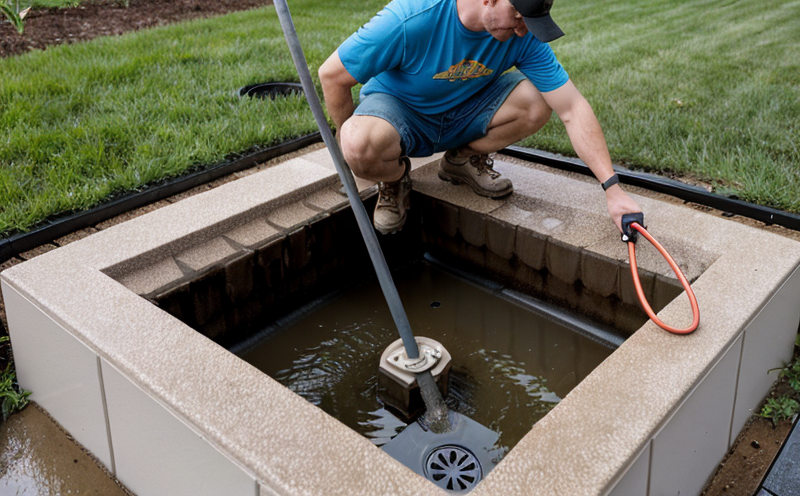Sump pump inspection
For quality managers and compliance officers in construction and building sectors, ensuring that sump pumps are functioning correctly is paramount. Sump pumps play a critical role in preventing basement flooding by removing water from the lowest part of buildings. The inspection process for these pumps involves detailed checks to ensure they meet safety standards and operational efficiency requirements.
The primary focus during an inspection includes verifying the pump's capacity, checking the float switch functionality, assessing the electrical connections, inspecting the discharge system, and ensuring proper installation. In compliance with international standards such as ISO 15026-3:2009, these inspections are crucial to guarantee that sump pumps meet industry benchmarks.
During the inspection process, R&D engineers must ensure that the pump's design aligns with modern safety and efficiency criteria. They also need to verify that the pump can handle expected water volumes without causing overloads or malfunctions. This involves understanding local building codes, such as those found in North American National Electrical Code (NEC) and International Residential Code (IRC), which provide guidelines on sump pump installation.
For procurement professionals, selecting a reliable supplier is essential. It's important to choose manufacturers who adhere strictly to these standards and undergo regular inspections to maintain quality assurance. This ensures that the equipment purchased meets not only current but also future regulatory requirements. Proper inspection of sump pumps helps avoid costly repairs or replacements down the line.
The importance of accurate documentation cannot be overstated. Compliance officers should ensure all tests are thoroughly documented, including any issues found during inspections and recommendations for corrective actions. This documentation serves as a critical reference point in case of audits or warranty claims. Additionally, it provides valuable data for continuous improvement efforts within the organization.
In summary, thorough inspection of sump pumps is essential to maintaining building safety and preventing potential failures that could lead to extensive damage. By adhering strictly to established protocols and standards, organizations can ensure their infrastructure remains robust against environmental challenges while complying with regulatory expectations.
Benefits
The benefits of regular inspections go beyond just meeting compliance requirements; they offer significant advantages that contribute directly to the overall health and longevity of a building. Regular sump pump inspections help identify potential problems early on, allowing for timely repairs before more severe issues arise.
- Prevent Water Damage: One of the most critical benefits is preventing water damage caused by unexpected failures or overflows. By ensuring that pumps are working correctly and efficiently, you reduce the risk of costly repairs and replacements due to flooding.
- Extend Lifespan: Proper maintenance helps extend the life span of your sump pump. Regular inspections help catch minor issues before they become major problems, thereby extending the useful life of the equipment.
- Increase Energy Efficiency: Ensuring that pumps operate efficiently contributes to better energy management within a facility. This can lead to reduced utility costs and more sustainable operations overall.
- Enhance Safety: A properly functioning sump pump is vital for maintaining safe living or working conditions, especially in areas prone to heavy rainfall or snowmelt. Regular inspections ensure that this critical safety measure remains effective.
By investing time and resources into regular sump pump inspections, organizations demonstrate their commitment to both operational efficiency and occupant safety. This proactive approach not only protects against future disruptions but also enhances reputation and builds trust among stakeholders.
Quality and Reliability Assurance
- Testing Methods: For quality assurance, we employ various testing methods to evaluate the performance of sump pumps. These include hydrostatic pressure tests which measure how well a pump handles high-pressure conditions; motor current draw checks that assess electrical efficiency; and flow rate measurements that ensure capacity meets specified standards.
- Data Collection: During inspections, detailed data is collected on various parameters such as power consumption, noise levels, vibration patterns, and overall efficiency. This information serves as a benchmark for future comparisons and helps identify trends over time.
To maintain high standards of reliability, we adhere strictly to recognized international standards like ISO 15026-3:2009, which provides guidelines on the performance evaluation of sump pumps. Our team of experts ensures that each pump meets these rigorous criteria before being certified as fit for use.
Regular maintenance and inspections are key components in our approach to quality assurance. By staying proactive rather than reactive, we minimize downtime and maximize operational efficiency across all facilities served by the inspected pumps.
Environmental and Sustainability Contributions
- Sustainable Practices: In an era where environmental responsibility is paramount, our sump pump inspection services contribute positively towards sustainable practices. By ensuring that pumps operate efficiently, we help reduce energy consumption and minimize the carbon footprint associated with building operations.
- Eco-friendly Solutions: We encourage the use of eco-friendly solutions in pump design and installation processes. This includes recommending models with high-efficiency motors and materials that are recyclable or biodegradable where possible.
The efficient removal of water from basements helps prevent contamination of groundwaters, which is beneficial for both immediate environmental conditions and long-term ecological health. By focusing on sustainable practices throughout the inspection process, we aim to create a more resilient built environment that stands up against future climate challenges.





